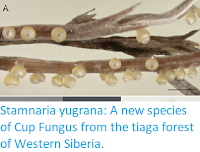The fossil Neocalamites is a Horsetail, Sphenopsida , known from Permian-Jurassic deposits around the world. In China Neocalamites has been reported from the Late Triassic of Xinjiang and Qinghai in the northwest of the country and Hubei Province in Central China, plus the Early Jurassic of North China.
In a paper published in the journal Acta Geologica Sinica on 11 March 2019, Li Zuochen of the Key Laboratory of Western China’s Mineral Resources and Geological Engineering at Chang’an University, and the Department of Geosciences at Eberhard Karls University Tübingen, Pei Xianzhi, also of the Key Laboratory of Western China’s Mineral Resources and Geological Engineering at Chang’an University, Wei Liyong of the No. 5 Gold Geological Party of China Armed Police Force, Guo Junfeng, Xiao Liang, Li Ruibao, and Pei Lei, also of the Key Laboratory of Western China’s Mineral Resources and Geological Engineering at Chang’an University, Zhao Wenchuan, also of the No. 5 Gold Geological Party of China Armed Police Force, Wang Meng, Chen Youxin, Liu Chengjun, Zhao Shaowei, Gao Feng, Shao Jiakun, and Qin Li, again of the Key Laboratory of Western China’s Mineral Resources and Geological Engineering at Chang’an University, and Zhao Changcun and Zhang Zhen, again of the No. 5 Gold Geological Party of China Armed Police Force, describe the first known occurence of Neocalamites from the West Qinling Orogenic Belt of Central China.
Li et al. report the discovery of numerous Neocalamites fossils from the Late Triassic Daheba Formation in Lintan County of Gansu Province, part of the West Qinling Orogenic Belt, which separates the North and South China Blocks. The specimens comprise trucks from 5 to 12.5 cm in length and from 0. 8 to 1.5 cm in diameter, with an internode length (length between the nodes from which leaves or stems arise of 6.2 to 10.5 cm.
Neocalamites Fossils from the Upper Triassic Daheba Formation in the Lintan Area, Western Section of the West Qinling Orogenic Belt. (a) Field photograph; (b) Samples photograph; (c)–(d) Micrographs. Li et al. (2019).
See also...
Follow Sciency Thoughts on Facebook.







